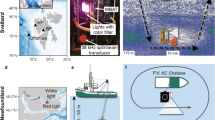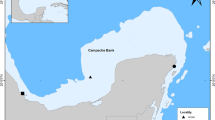Abstract
The spectral sensitivities of 12 species of mesopelagic crustaceans were studied by means of electrophysiological recordings. Nine of the species are vertical migrators, while 3 are not, and 9 species possess bioluminescent organs, while 3 are not bioluminescent. All species had a single peak of spectral sensitivity with maxima between 470 nm and 500 nm. There was no apparent correlation between sensitivity maxima and daytime depth distribution, migratory behavior, or the presence or absence of bioluminescent organs. With the exception of the hyperiid amphipod Phronima sedentaria, the spectral sensitivities of these mesopelagic crustaceans demonstrate a better match for maximum sensitivity to bioluminescence than to downwelling light.
Similar content being viewed by others
Author information
Authors and Affiliations
Additional information
Accepted: 29 June 1999
Rights and permissions
About this article
Cite this article
Frank, T., Widder, E. Comparative study of the spectral sensitivities of mesopelagic crustaceans. J Comp Physiol A 185, 255–265 (1999). https://doi.org/10.1007/s003590050385
Issue Date:
DOI: https://doi.org/10.1007/s003590050385




